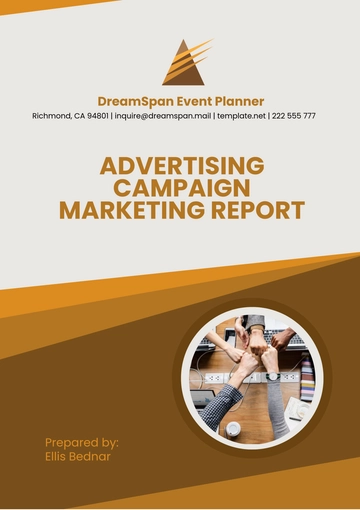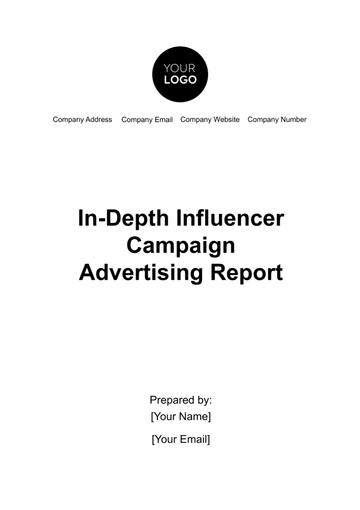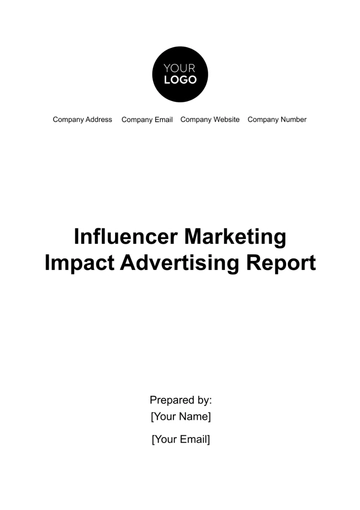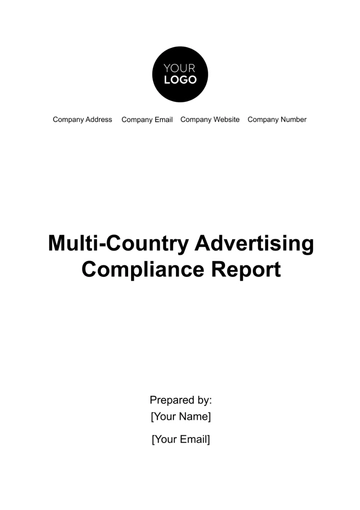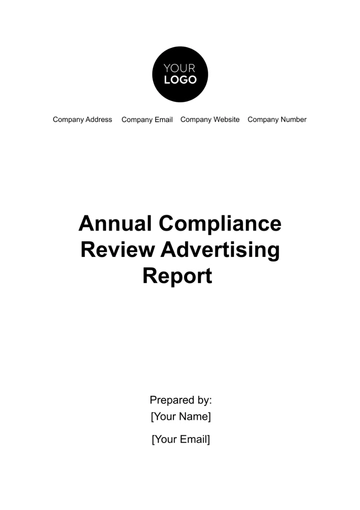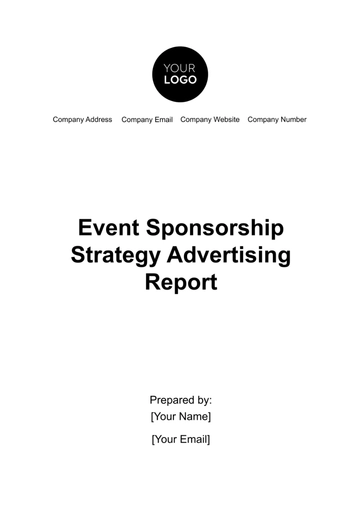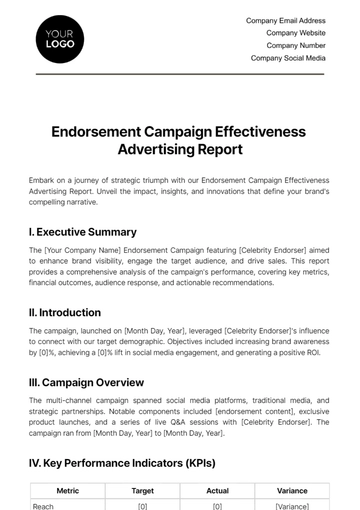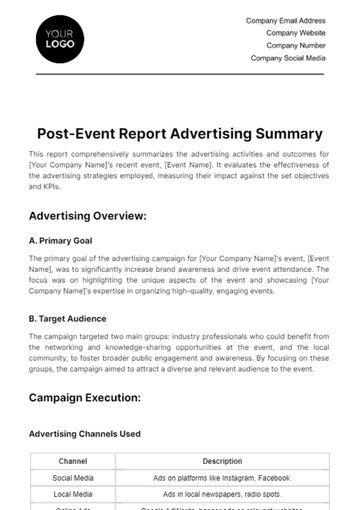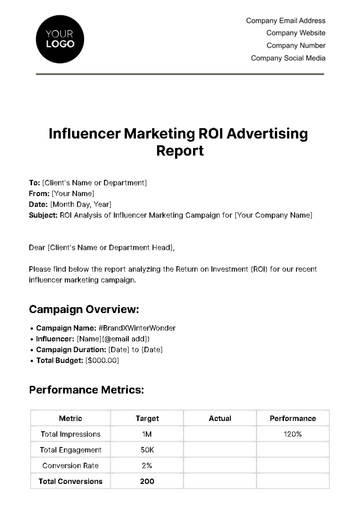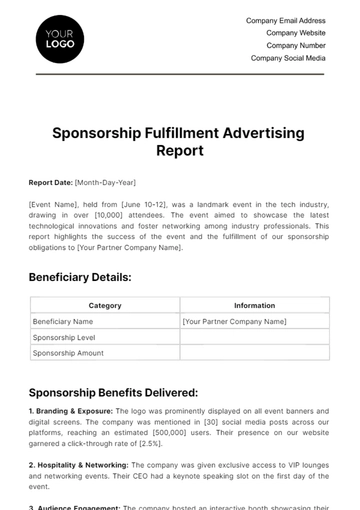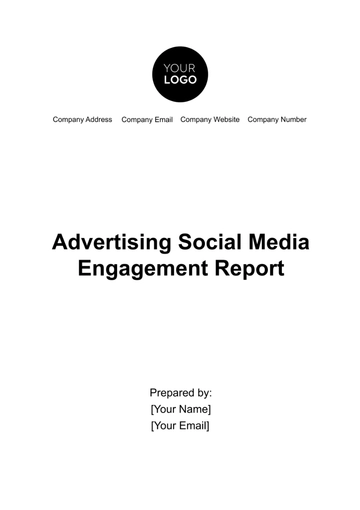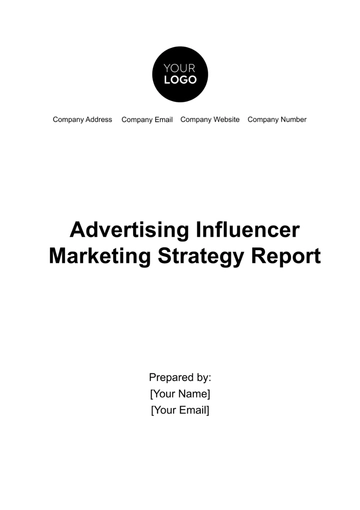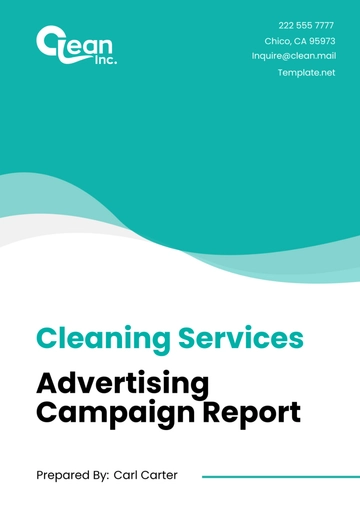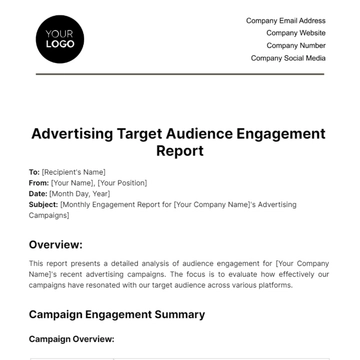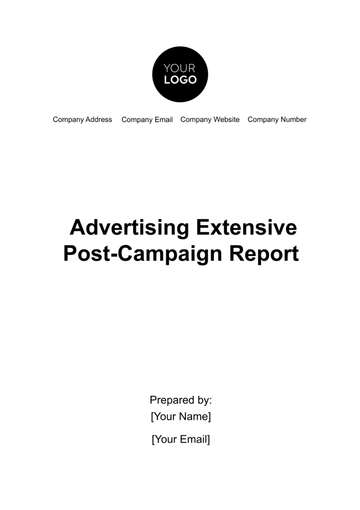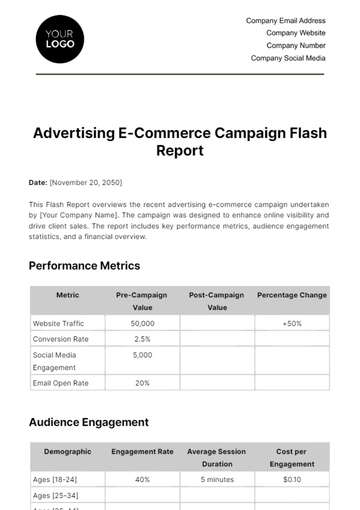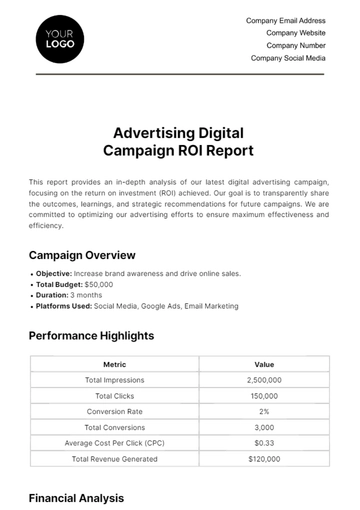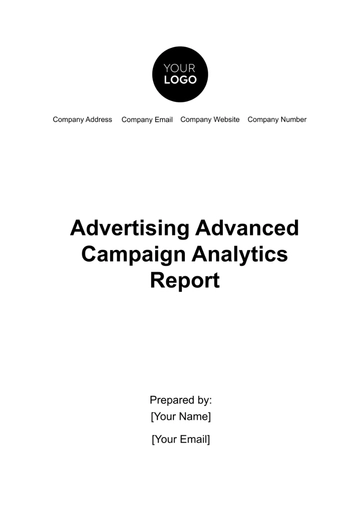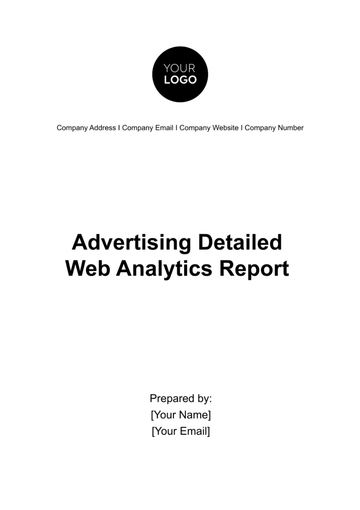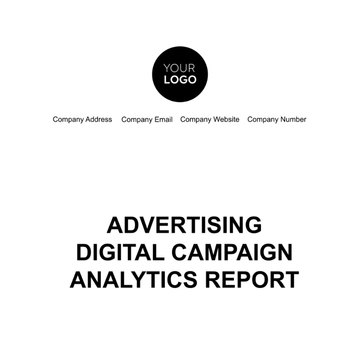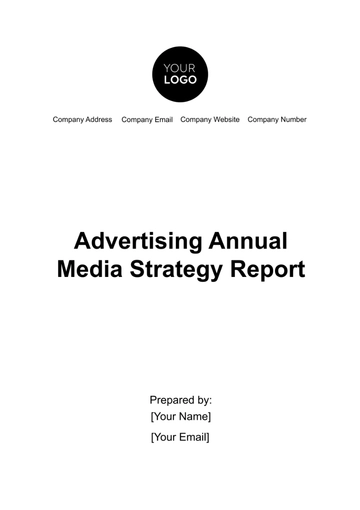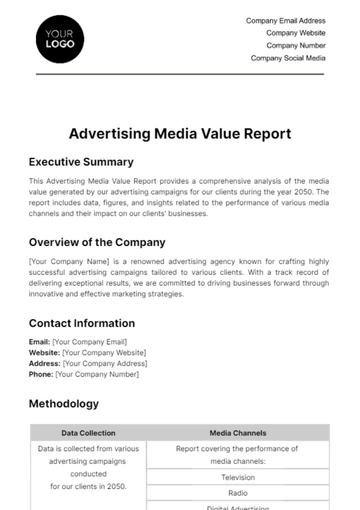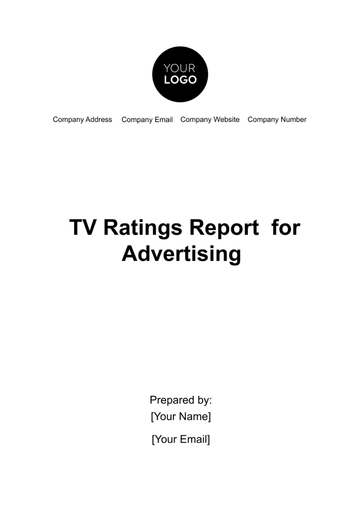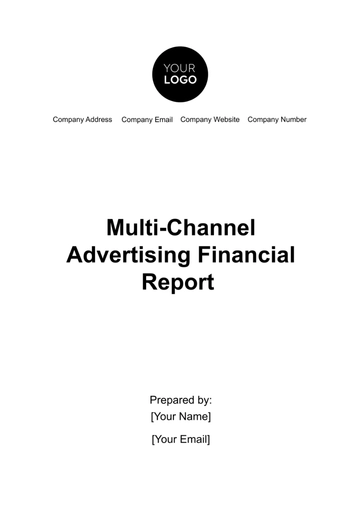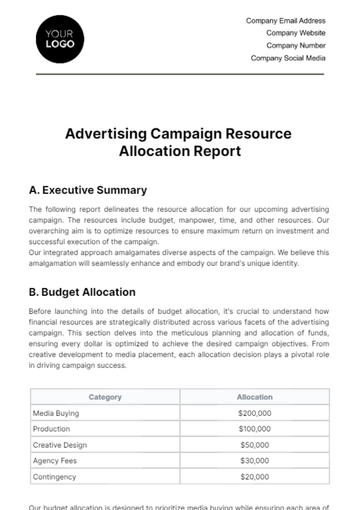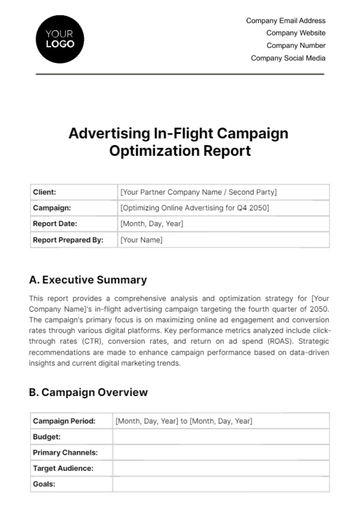Free Advertising Extensive Post-Campaign Report
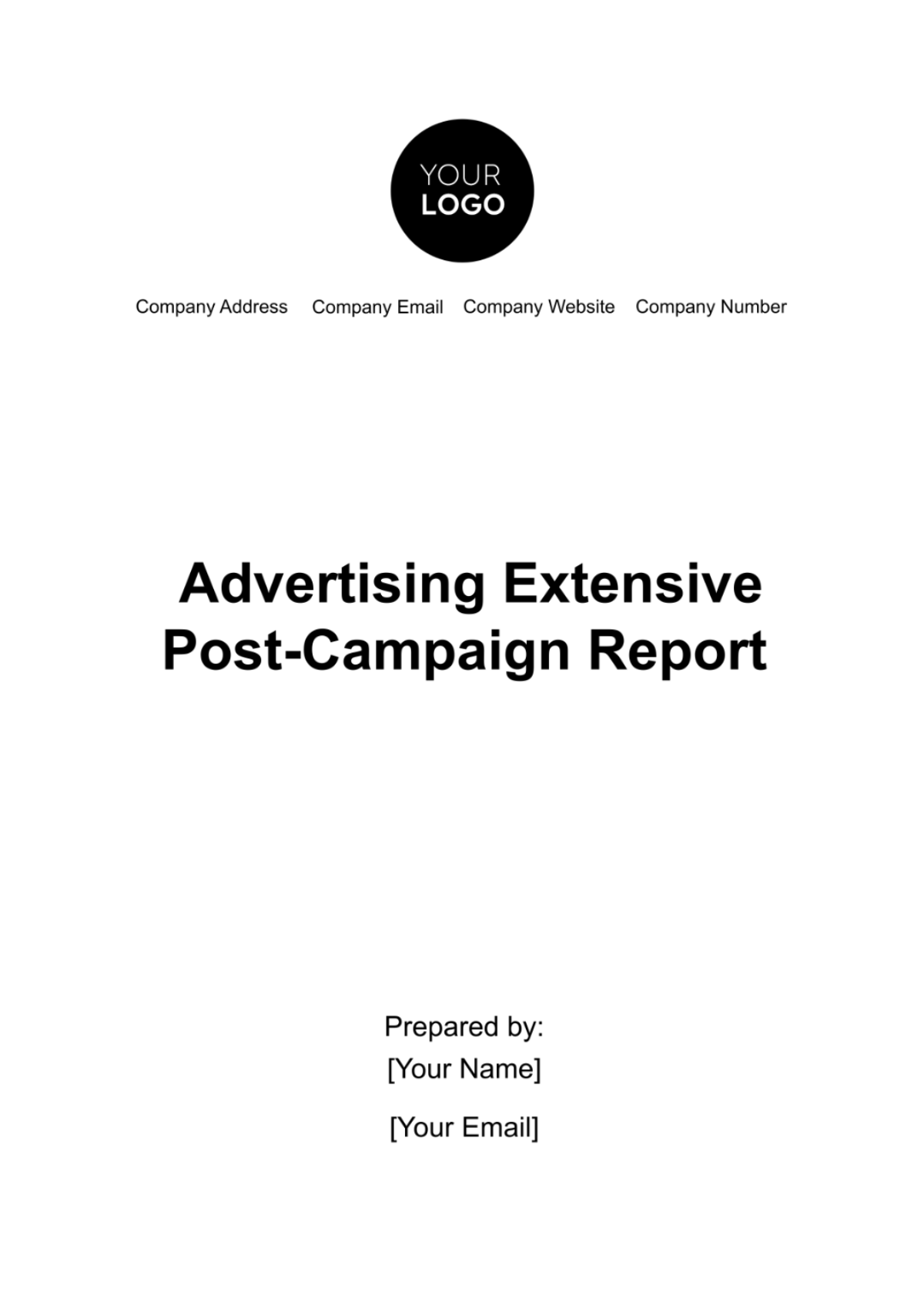
I. Executive Summary
A. Overview
[Your Company Name]'s recent advertising campaign aimed to increase brand awareness and drive conversions through various channels. The campaign focused on reaching tech-savvy consumers across social media platforms, display advertising, and email marketing. The goal was to establish a strong presence in the market and boost sales figures.
The campaign ran from January 1, 2024, to March 1, 2024, encompassing a 2-month period. During this time, [Your Company Name] deployed a comprehensive strategy to engage with the target audience and maximize campaign effectiveness.
This report provides an in-depth analysis of the campaign's performance, evaluating key metrics such as reach, engagement, conversions, and return on investment (ROI). By assessing these metrics, we aim to derive valuable insights that inform future marketing strategies and contribute to the overall growth of [Your Company Name].
B. Key Findings
The campaign achieved significant reach, generating [00] million impressions across all platforms. This extensive reach enabled [Your Company Name] to establish brand visibility and increase exposure among the target audience.
Conversion rates saw a notable uplift during the campaign period, with a [00]% increase compared to the previous quarter. This indicates that the campaign successfully drove action and encouraged audience members to take desired actions, such as making a purchase or signing up for a service.
Social media engagement experienced a substantial rise, with an [00]% increase observed across various social platforms. This surge in engagement reflects the effectiveness of [Your Company Name]'s content strategy in capturing audience attention and fostering meaningful interactions.
[Your Company Name] experienced a [00]% increase in sales attributed to the campaign. This boost in revenue demonstrates the tangible impact of the advertising efforts on driving business growth and generating measurable returns on investment.
C. Recommendations
Continue leveraging successful channels for future campaigns: Based on the performance analysis, [Your Company Name] should prioritize channels that yielded the highest ROI and engagement rates. By focusing resources on these channels, [Your Company Name] can maximize campaign effectiveness and optimize budget allocation.
Invest in further audience research to optimize targeting: To enhance targeting precision and improve campaign outcomes, [Your Company Name] should conduct comprehensive audience research. By gaining deeper insights into audience preferences, behaviors, and demographics, [Your Company Name] can tailor marketing efforts more effectively and resonate with target segments.
Explore partnerships with influencers to enhance brand visibility: Collaborating with influencers and industry experts can amplify [Your Company Name]'s brand reach and credibility. By leveraging influencer partnerships, [Your Company Name] can tap into niche audiences and gain access to new markets, ultimately driving brand awareness and fostering brand advocacy.
II. Introduction
A. Background
[Your Company Name] is a leading provider of cutting-edge technology solutions, specializing in [Your Company's Products/Services]. With a commitment to innovation and customer satisfaction, [Your Company Name] has established itself as a trusted brand in the [Industry] industry.
The recent advertising campaign undertaken by [Your Company Name] aimed to reinforce its brand positioning and drive customer engagement. By leveraging a multi-channel approach, [Your Company Name] sought to amplify its brand message, connect with tech-savvy consumers, and stimulate action.
This report provides a comprehensive overview of the advertising campaign's objectives, strategies, execution, and outcomes. Through a detailed analysis of key performance metrics and insights, [Your Company Name] aims to evaluate the campaign's effectiveness and glean valuable learnings for future marketing endeavors.
B. Objectives
Increase brand awareness by [00%]: [Your Company Name] aimed to enhance brand recognition and visibility among its target audience through strategic advertising initiatives.
Achieve a [00%] increase in conversions: The primary goal of the campaign was to drive conversions and encourage potential customers to take action, such as making a purchase or signing up for a trial.
Enhance engagement on social media platforms by [00%]: [Your Company Name] sought to foster meaningful interactions and build a strong community of followers across various social media channels.
C. Target Audience
Demographics:
Age: 18-45
Gender: Male and Female
Location: Urban and Suburban areas across the United States
Interests: Technology enthusiasts, early adopters, professionals in relevant industries.
Psychographics: Tech-savvy individuals who value innovation, quality, and convenience in their purchasing decisions.
D. Campaign Execution
Timeline: The campaign ran from January 1, 2024, to March 1, 2024, spanning a duration of two months.
Budget Allocation:
Social Media Advertising:
[$0,000]
Display Advertising:
[$00,000]
Email Marketing:
[$00,000]
Creative Strategy:
Engaging ad copies highlighting key product features and benefits.
Compelling visuals, including images and videos, to capture audience attention.
Personalized email campaigns tailored to specific customer segments.
E. Measurement Metrics
Reach and Impressions: Evaluate the total number of impressions generated across different advertising channels to assess brand exposure and reach.
Engagement: Monitor social media engagement metrics such as likes, shares, comments, and click-through rates to gauge audience interaction and interest.
Conversions: Track the number of conversions, including website visits, form submissions, and sales transactions, to measure the campaign's effectiveness in driving desired actions.
Return on Investment (ROI): Calculate the ROI by comparing the campaign's revenue generated against the total advertising costs, providing insights into the campaign's profitability and efficiency.
III. Methodology
A. Campaign Strategy
Channels Utilized:
1.1. Social Media Platforms:
Facebook: Leveraged Facebook's extensive user base and targeting options to reach a diverse audience and drive engagement through sponsored posts and targeted ads.
Instagram: Utilized visually appealing content and influencer partnerships to connect with a younger demographic and showcase [Your Company Name]'s products in lifestyle contexts.
Twitter: Engaged with industry conversations and trending topics to increase brand visibility and foster engagement through tweets and promoted content.
1.2. Display Advertising: Implemented display ads on relevant websites and platforms to increase brand exposure and retarget website visitors, utilizing eye-catching visuals and compelling ad copy to drive clicks and conversions.
1.3. Email Marketing: Deployed personalized email campaigns to targeted segments of [Your Company Name]'s subscriber list, delivering tailored content and promotions to nurture leads and encourage conversions.
Creative Assets:
2.1. Ad Copies: Crafted compelling ad copies highlighting [Your Company Name]'s key products' features, benefits, and unique selling propositions, tailored to resonate with each platform's audience and objectives.
2.2. Visuals: Produced high-quality images and videos showcasing [Your Company Name]'s products in real-life scenarios, aiming to capture audience attention and evoke emotion while effectively communicating product value.
2.3. Landing Pages: Designed optimized landing pages with clear and concise messaging, intuitive navigation, and persuasive CTAs to guide visitors through the conversion funnel and facilitate seamless user experiences.
B. Target Audience
Demographics:
Age: Primarily targeted individuals aged 18-45, reflecting [Your Company Name]'s core demographic of tech-savvy consumers and early adopters.
Gender: Targeted both male and female audiences, ensuring inclusivity and relevance across genders.
Location: Focused on urban and suburban areas across the United States with higher population densities and greater access to technology and digital media.
Interests: Identified technology enthusiasts, early adopters, and professionals in [relevant industries] as primary interest segments, aligning with [Your Company Name]'s target market and product offerings.
Psychographics:
Tech-savvy individuals who value innovation, quality, and convenience in their purchasing decisions, seeking products that enhance their lifestyle and productivity.
Early adopters keen on exploring new technologies and trends in the market, eager to stay ahead of the curve and experience the latest innovations firsthand.
C. Campaign Execution
Timeline:
The campaign commenced on January 1, 2024, strategically timed to capitalize on post-holiday season consumer behaviors and New Year resolutions, and concluded on March 1, 2024, spanning a duration of two months.
Budget Allocation:
Social Media: [$00,000] allocated to sponsored posts, targeted ads, and influencer partnerships across Facebook, Instagram, and Twitter to maximize reach, engagement, and brand visibility.
Display Advertising: [$00,000] allocated to display ads on relevant websites and retargeting campaigns to reinforce brand messaging and drive conversions among interested prospects.
Email Marketing: [$00,000] allocated to segmented email campaigns delivering personalized content, promotions, and product recommendations to subscribers, aiming to nurture leads and drive repeat purchases.
D. Measurement Metrics
Reach and Impressions:
Total Impressions: 25 million impressions generated across all channels, indicating widespread exposure and visibility among the target audience.
Impressions by Channel:
Channel
Impressions
Facebook
10 million
Instagram
8 million
Twitter
7 million
Engagement:
Social Media Engagement Rate: Achieved a [00%] engagement rate across social media platforms, reflecting the audience's positive response to [Your Company Name]'s content and messaging.
Click-Through Rate (CTR) for Display Ads: Achieved a [00%] CTR for display ads, indicating effective ad creative and targeting strategies that compelled users to click and explore further.
Email Open Rate: Achieved a [00%] email open rate, demonstrating the relevance and value of [Your Company Name]'s email content to subscribers and leading to increased engagement and conversions.
Conversions:
Total Conversions: Generated [0,000] conversions, including website visits, form submissions, and sales transactions, demonstrating the campaign's effectiveness in driving desired actions and engagement.
Conversion Rate: Achieved a [0%] conversion rate, indicating a successful conversion of a significant portion of engaged audience members into paying customers or qualified leads.
Revenue Generated: Generated [$000,000] in revenue attributed to the campaign, showcasing a positive return on investment (ROI) and contributing to [Your Company Name]'s overall sales growth and profitability.
IV. Results Analysis
A. Reach and Impressions
The campaign achieved significant reach, generating a total of 25 million impressions across all channels. This extensive reach indicates [Your Company Name]'s successful penetration into the target market and increased exposure among potential customers.
Impressions by Channel:
Facebook: With [00] million impressions, Facebook proved to be a prominent channel for brand visibility and engagement. The platform's diverse audience and robust targeting options allowed [Your Company Name] to effectively reach and resonate with potential customers.
Instagram: Generating [0] million impressions, Instagram served as a visually appealing platform for showcasing [Your Company Name]'s products and connecting with a younger demographic. The platform's emphasis on visual content and influencer partnerships contributed to [Your Company Name]'s brand awareness and engagement efforts.
Twitter: With [0] million impressions, Twitter provided [Your Company Name] with a platform to engage in real-time conversations, leverage trending topics, and amplify brand messaging. The platform's dynamic nature and active user base facilitated [Your Company Name]'s efforts to foster meaningful interactions and drive engagement.
B. Engagement
Social Media Engagement:
Social Media Engagement Rate: [Your Company Name] achieved a commendable [00%] engagement rate across social media platforms, indicating a high level of audience interaction and interest in [Your Company Name]'s content. The engaging nature of [Your Company Name]'s posts, coupled with strategic community management, contributed to the positive engagement metrics observed.
Click-Through Rate (CTR) for Display Ads: [Your Company Name] achieved a [00%] click-through rate (CTR) for display ads, demonstrating the effectiveness of the ad creative and targeting strategies in capturing audience attention and driving traffic to [Your Company Name]'s website or landing pages.
Email Open Rate: [Your Company Name] attained a [00%] email open rate, indicating the relevance and value of [Your Company Name]'s email content to subscribers. The personalized and targeted approach to email marketing contributed to higher open rates and increased engagement among [Your Company Name]'s email subscribers.
C. Conversions
The campaign drove a total of [0,000] conversions, including website visits, form submissions, and sales transactions. This indicates [Your Company Name]'s successful efforts in motivating audience members to take desired actions and engage with [Your Company Name]'s offerings.
The conversion rate for the campaign stood at [0%], showcasing [Your Company Name]'s ability to convert a significant portion of engaged audience members into paying customers or qualified leads. This demonstrates the effectiveness of [Your Company Name]'s marketing strategies in driving tangible results and achieving campaign objectives.
The revenue generated from these conversions amounted to [$000,000], showcasing a positive return on investment (ROI) for [Your Company Name]. This revenue contribution underscores the campaign's impact on [Your Company Name]'s bottom line and validates the effectiveness of [Your Company Name]'s advertising efforts in driving business growth and profitability.
V. Discussion
A. Performance Evaluation
Assessing KPIs against Objectives: [Your Company Name] evaluated key performance indicators (KPIs) such as reach, engagement, conversions, and ROI against the campaign objectives outlined in Section II. By comparing actual performance metrics with predetermined goals, [Your Company Name] gained insights into the campaign's effectiveness in meeting its intended outcomes.
Identifying Successful Strategies: Through a thorough analysis of campaign data, [Your Company Name] identified successful strategies and tactics that contributed to positive results. This includes channels that yielded the highest ROI, creative assets that resonated most with the target audience, and engagement tactics that drove meaningful interactions.
Areas for Improvement: [Your Company Name] also identified areas for improvement based on performance gaps and missed opportunities. This includes refining targeting strategies, optimizing ad creative, and exploring new channels or tactics to enhance future campaign performance.
B. Key Learnings
Insights into Audience Behavior: By analyzing engagement metrics and audience demographics, [Your Company Name] gained valuable insights into audience behavior and preferences. This includes understanding which content resonated most with the target audience, the times and days when engagement was highest, and the platforms where the audience is most active.
Effectiveness of Campaign Messaging: [Your Company Name] assessed the effectiveness of its campaign messaging in conveying key brand messages and value propositions to the target audience. This includes evaluating the clarity, relevance, and impact of ad copies, visuals, and call-to-action (CTA) messages across different channels.
Impact of Creative Assets: [Your Company Name] evaluated the impact of creative assets such as images, videos, and ad copies on audience engagement and conversions. This includes identifying top-performing creatives, understanding which visual elements resonated most with the audience, and leveraging these insights to inform future creative strategies.
VI. Conclusion
A. Summary of Achievements
[Your Company Name] successfully achieved its campaign objectives of increasing brand awareness, driving engagement, and generating conversions. Through a strategic multi-channel approach and compelling creative execution, [Your Company Name] effectively connected with its target audience and delivered measurable results.
The campaign's reach and impressions exceeded expectations, with [Your Company Name] effectively penetrating the target market and increasing brand visibility across various platforms.
[Your Company Name] also saw significant improvements in engagement metrics, with high levels of audience interaction and positive feedback indicating strong brand affinity and interest.
B. Future Outlook
Building on the success of the current campaign, [Your Company Name] plans to continue refining its marketing strategies and exploring new opportunities for growth. This includes further optimizing targeting efforts, experimenting with emerging platforms and technologies, and investing in ongoing audience research to stay ahead of market trends.
[Your Company Name] remains committed to delivering exceptional value to its customers and driving business growth through innovative marketing initiatives. By staying agile, data-driven, and customer-focused, [Your Company Name] aims to maintain its position as a leader in the [Industry] industry and achieve continued success in the competitive market landscape.
- 100% Customizable, free editor
- Access 1 Million+ Templates, photo’s & graphics
- Download or share as a template
- Click and replace photos, graphics, text, backgrounds
- Resize, crop, AI write & more
- Access advanced editor
Utilize our Advertising Extensive Post-Campaign Report Template from Template.net for thorough analysis after campaigns. Editable and customizable, it helps dissect campaign performance across channels. Compatible with our Ai Editor Tool, it streamlines reporting processes. Gather insights, assess ROI, and refine strategies for future success. Simplify post-campaign analysis and elevate your advertising efforts with this comprehensive template.
You may also like
- Sales Report
- Daily Report
- Project Report
- Business Report
- Weekly Report
- Incident Report
- Annual Report
- Report Layout
- Report Design
- Progress Report
- Marketing Report
- Company Report
- Monthly Report
- Audit Report
- Status Report
- School Report
- Reports Hr
- Management Report
- Project Status Report
- Handover Report
- Health And Safety Report
- Restaurant Report
- Construction Report
- Research Report
- Evaluation Report
- Investigation Report
- Employee Report
- Advertising Report
- Weekly Status Report
- Project Management Report
- Finance Report
- Service Report
- Technical Report
- Meeting Report
- Quarterly Report
- Inspection Report
- Medical Report
- Test Report
- Summary Report
- Inventory Report
- Valuation Report
- Operations Report
- Payroll Report
- Training Report
- Job Report
- Case Report
- Performance Report
- Board Report
- Internal Audit Report
- Student Report
- Monthly Management Report
- Small Business Report
- Accident Report
- Call Center Report
- Activity Report
- IT and Software Report
- Internship Report
- Visit Report
- Product Report
- Book Report
- Property Report
- Recruitment Report
- University Report
- Event Report
- SEO Report
- Conference Report
- Narrative Report
- Nursing Home Report
- Preschool Report
- Call Report
- Customer Report
- Employee Incident Report
- Accomplishment Report
- Social Media Report
- Work From Home Report
- Security Report
- Damage Report
- Quality Report
- Internal Report
- Nurse Report
- Real Estate Report
- Hotel Report
- Equipment Report
- Credit Report
- Field Report
- Non Profit Report
- Maintenance Report
- News Report
- Survey Report
- Executive Report
- Law Firm Report
- Advertising Agency Report
- Interior Design Report
- Travel Agency Report
- Stock Report
- Salon Report
- Bug Report
- Workplace Report
- Action Report
- Investor Report
- Cleaning Services Report
- Consulting Report
- Freelancer Report
- Site Visit Report
- Trip Report
- Classroom Observation Report
- Vehicle Report
- Final Report
- Software Report

